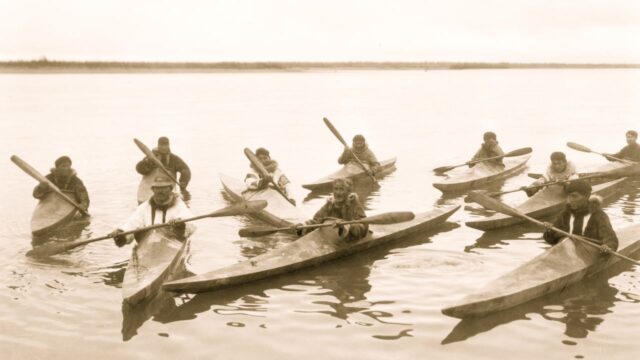By Kara Nelson, CNN
(CNN) — What do snow goggles, suspension bridges, and lacrosse have in common? They are all innovations that were created by Native Americans thousands of years ago that we still use today.
Many Native American contributions to our modern world often go unrecognized, according to Gaetana DeGennaro, a museum specialist at the Smithsonian National Museum of the American Indian.
“When people are learning about Native people, you get ‘They make beautiful baskets and beautiful pottery and jewelry.’ But not that Native people were thinking and using science,” DeGennaro said.
Over thousands of years, Native Americans developed their own sciences and recreational and medical practices using animals and natural resources in their environment.
“And many of these innovations continue today and it’s important that these contributions to the world are known,” DeGennaro said.
Snow Goggles
Snow goggles were invented by the Inuit and Yupik Indians, Arctic native people who lived in modern day Alaska.
DeGennaro told CNN the goggles were often carved from driftwood, whale bones, and walrus ivory.
“They would fit snugly across your eyes and they would have slits and these slits would reduce the amount of glare coming into your eyes,” she said.
The slits allowed Native Americans to maintain their vision while they were hunting and moving through dangerous weather.
These eye coverings were a vital survival tool for Native Americans living in snow-covered environments, which were often located high in the mountains where the air was much thinner.
Exposure to these harsh climates could cause snow blindness, DeGennaro said, which is caused by UV rays reflecting off of ice and snow.
The ancient frames were also lined with dark materials on the inside to reduce harmful glare – similar to how today’s football and baseball players put black strips under their eyes for the same reason.
“It’s almost like squinting your eyes in the sun,” DeGennaro said. “I would say that the snow goggles are the predecessor of today’s sunglasses.”
Kayaks
Kayaks are another invention credited to the Indigenous people of the Arctic and were used for traveling and gathering food.
Native people used driftwood and large animal bones to carve a closed narrow boat with a hole big enough for one person to fit snugly inside.
The boats were “very sleek in design and easy to maneuver,” DeGannaro said.
The boats were able to float using walrus or seal skin, DeGannaro said, adding Native Americans would wrap the kayak in the aquatic skins which are naturally water and windproof due to their oil glands.
DeGannaro said the person sitting inside the kayak would also wear a waterproof jacket made out of seal or walrus intestines.
“(Kayaks) were developed for different types of water,” DeGannaro said. “It could be a kayak that was for the calm waters of a lake, or rapid rivers, or a kayak for the rough ocean water.”
Kayaks have been used to cross waterways for thousands of years and while the materials have changed, the design of the vessel has essentially remained the same. Today, kayaking is a summer Olympic sport, and a hobby enjoyed by millions across the world.
Lacrosse
Lacrosse – originally known as stickball – is considered to be America’s oldest team sport.
DeGannaro said the sport originated with Haudenosaunee people, who are located in upstate New York and Canada.
The game was originally played with wooden sticks and deerskin balls filled with fur.
In addition to playing for recreational purposes, DeGannaro said Indigenous people “would play this game to resolve the disputes instead of warring.”
But in this instance, the rules were “very different,” she added.
The game could be played for miles, with little to no boundaries, she said, and include well over 100 players. A single game could last for days, even weeks.
In 1625, Jean de Brebeuf, a Jesuit missionary, witnessed Native people playing stickball and is thought to be the first to document the sport and name it lacrosse.
DeGannaro said today it’s likely most players are unaware of the sports origins or its meaning to Native communities.
“It’s more to what they’re just playing as a sport, more spirituality to it,” she said. “It was a sacred game.”
Hammocks
The word “hammock,” DeGannaro said, is derived from the Arawak word “hamaka.”
DeGannaro said long before Europeans were introduced to the concept, Native people invented the hammock in the Caribbean.
The Taino people, a member of Arawak, are the Central American and Carribean Natives that Christopher Columbus encountered when he landed in the islands.
In his journals, Columbus documented Indigenous people laying in “nets of cotton” that were suspended between two poles. The nets were made from different natural materials found in the environment, which were then woven into various knot patterns.
The beds were “portable so you can take it from place to place, you can put it up in your home or you can put it outside,” DeGannaro said. The raised design of the hammock kept Native Americans cool on humid nights and protected them from wild animals like snakes, she said.
Suspension bridges
The suspension bridge, DeGannaro said, is an engineering feat originating from the Inca in the Andes region, who designed the bridges as they were developing their empire.
The Andes run along the west coast of South America, a region characterized by mountains and rivers. DeGannaro said traversing the mountainous environment posed a challenge for Indigenous people.
Using natural grasses and plants, along with llama and alpaca hair, Native Americans would weave “those grasses into these suspension bridges, that could span 100 ft across,” DeGannaro said.
The bridges were typically constructed high in the air, she added. This innovation saved Native Americans from having to make dangerous trek up and down the mountains in the region.
And while most people would consider a bridge made from grass and animal hair to be unsafe, DeGannaro said they were woven to withstand heavy weight and strong winds.
“They were so strong that you could walk across and you could bring llamas and carry loads,” DeGannaro said. “When the Spaniards came, they brought their horses and ammunition across those bridges.”
Native Americans would use a twisting method to create a tight woven chord from the grasses and animal fur. They woud then use the chords to create a large cable, DeGannaro said.
This same wrapping method still exists today in the construction of the world’s most famous suspension bridges, such as the Golden Gate Bridge, she added.
“There’s a lot of things around you that you don’t know come from Native Americans, and you may use them every day,” DeGannaro said.
The-CNN-Wire
™ & © 2023 Cable News Network, Inc., a Warner Bros. Discovery Company. All rights reserved.




























